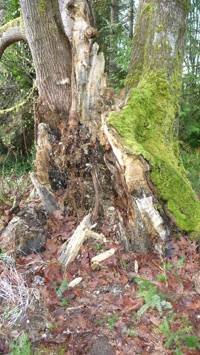Lorraine Hart, Special to KP News
 Ticks like the softer rotting trees, woodpiles, and leaf piles for nesting. The dark black stuff is where the ticks nest. Ticks have a two-year life cycle and they don't die in winter, due to the warm nests and warm hosts coming by. Photo by Lorraine Hart, Special to the KP News
Ticks like the softer rotting trees, woodpiles, and leaf piles for nesting. The dark black stuff is where the ticks nest. Ticks have a two-year life cycle and they don't die in winter, due to the warm nests and warm hosts coming by. Photo by Lorraine Hart, Special to the KP News
In the few years since Colleen Slater’s interview and story of my daughter Anna Hart in the Key Pen News, Washington State’s official count of Lyme disease cases has risen from just a handful to hundreds. The CDC admits numbers could be 10 to 15 times the amount recorded, and that Lyme disease cases are at least four times the number of HIV/AIDS cases in America. Northern California is endemic for tick-borne diseases and it’s known that ticks prefer a more moist, cool climate, moving north easily on migrating birds.
It is so important to be educated, whether you live in the woods or in town. This is why all Lyme Advocacy groups try to push the campaign, in every state, that May is Lyme Awareness Month. In May, nymph ticks can be as small as poppy seeds, but carry the same gutful of bacteria and viruses as adults.
Caught early, Lyme can be easily taken care of with antibiotics. Left in the old-fashioned wait and see mode, patients can go into the tertiary stage of Lyme and spend the rest of their lives fighting horrendous symptoms, symptoms that mimic over three hundred other diseases such as ALS (Lou Gehrig’s disease) Rheumatoid Arthritis, Lupus, and Multiple Sclerosis. Is it a coincidence that the Pacific Northwest has the highest numbers of MS in the nation?
Not all patients present with a bullseye rash, and a rash can be hidden under hair or in folds of skin. A bullseye rash is now considered a definitive diagnosis of Lyme in America. Unfortunately the rash, if present, has often disappeared by the time a patient feels ill enough to see a doctor.
Beginning symptoms can seem mostly flu-like, nausea, aching joints, headaches, etc, but again Lyme has no specific playbook.
The Lyme spirochete stays in the bloodstream only long enough to ‘read’ a host’s systems, before corkscrewing its way anywhere it pleases in the body.
There are some very simple measures that can be taken to protect yourself and your children from bites. Before working or playing outside, dress in light-colored clothing, long sleeves, pants tucked into socks and don’t forget a hat. A Deet spray can be used on clothing. When you come in, clothes can be put in the dryer on high heat, before you put them in the washer. Dryer heat will kill ticks but they live through the wash cycle. Make sure your pets are protected from ticks as well as fleas, all year round. Be particularly vigilant around old wood or leaf piles, rotting maples and trail edges. Check yourself and each other for ticks after being outside. Learn how to safely remove ticks, and make sure to keep them, as the tick is easier to test than the human for bacterial and viral infections. Ask for the documentary “Under Our Skin” at the Key Center Library. Enjoy May and keep safe out there.
For more information about Lyme disease, visit www.ilads.org or www.lymeinfo.net.
UNDERWRITTEN BY THE FUND FOR NONPROFIT NEWS (NEWSMATCH) AT THE MIAMI FOUNDATION, THE ANGEL GUILD, ADVERTISERS, DONORS AND PEOPLE WHO SUPPORT INDEPENDENT, NONPROFIT LOCAL NEWS